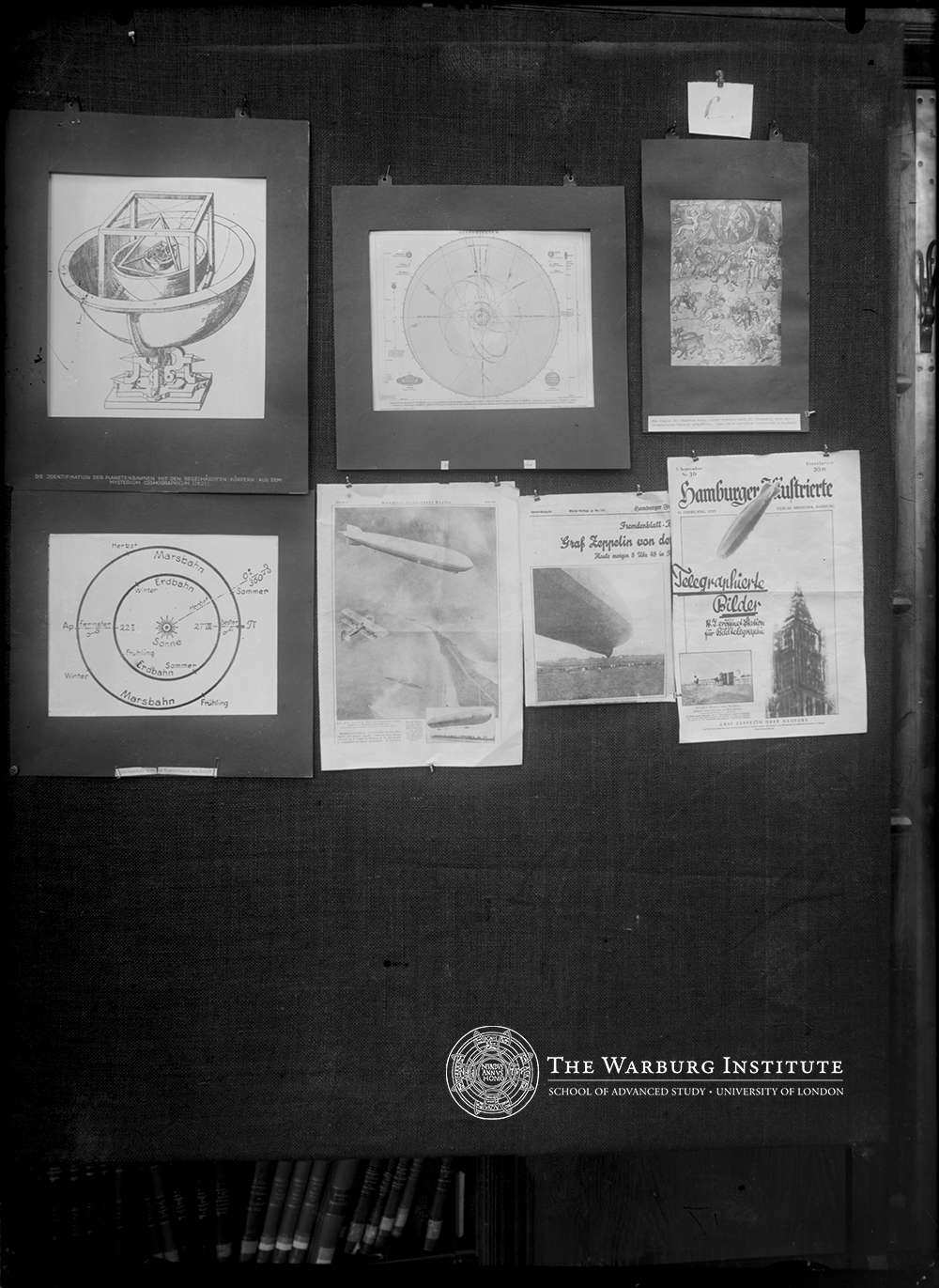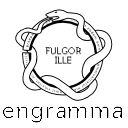Mnemosyne Atlas C
Figli di Marte. La conquista del cielo: guerra e tecnica
L’evoluzione dell’immagine di Marte come exemplum di raffigurazione di una traiettoria culturale: dalla rappresentazione antropomorfica della divinità astrale, all’immagine ‘imperfetta’ delle orbite non più circolari ma ellittiche dei pianeti, che mette in crisi il sistema di rapporti dei magico-armonici tra uomo e cosmo (Keplero), fino alle raffigurazioni attuali dalla scoperta dell'orbita ellittica di Marte alla conquista (intellettuale e materiale) del cielo.
Sons of Mars. The conquest of the sky: war and technology
The evolution of the image of Mars as an exemplum of representation of a cultural trajectory: from the anthropomorphical representation of the astral divinity, to the imperfect image of the circular movements of the planet which is still part of a system of magical and harmonious relationships between man and the cosmos (Kepler), to current representations of the conquest (intellectual and material) of the heavens.

Appunti di Aby Warburg (1929)
bis Kepler u. weiter zu Zeppelin
In Keplero e poi verso lo Zeppelin.
Appunti di Aby Warburg e collaboratori (1929)
Entwicklung der Marsvorstellung. Loslösung von der anthropomorphistischen. Auffassung Bild – harmonikales System – Zeichen.
Evoluzione della concezione di Marte. Distacco dalla concezione antropomorfica. Immagine – sistema armonicale – segno.
Appunti di Gertrud Bing (1940 ca)
Stufen der Überwindung der Furcht vor der Kosmos. Gefühl des Ausgeliefertseins (in d. HS) führ zur Bevölkerung des Kosmos mit Schreckgestalten. Mars gewählt wegen Kepler. Perseus auch auf dem Blatt. Dann kommen die Epizyklen des Tycho Brahe. Minutendifferenz führt zur Verbesserung. Regelmäßige Körper ist Keplers erster Versuch – also auch noch geleitet von harmonikalen Erwägungen. Endlich Marsbahn NB. Brief Keplers an Rud. II. Erfolg der Überwindung: auf der Reise nach Ostasien umschifft des Zepp. ein Gewitter (Cf. Marsblatt) durch Fernmeldung – Thermometer.
Fasi di superamento della paura del cosmo. La sensazione di essere in balia delle potenze cosmiche (nel manoscritto) porta a popolare il cosmo di figure terrificanti. Marte scelto per via di Keplero. Anche Perseo è sulla pagina [Tavola]. A seguire gli epicicli di Tycho Brahe. La minima differenza conduce a una evoluzione. I corpi regolari sono il primo esperimento di Keplero – che è quindi ancora legato a una concezione armonica del cosmo. Infine l’orbita di Marte. N.B. Lettera di Keplero a Rodolfo II. Successo di questo superamento: durante il viaggio verso l’Asia orientale, lo Zeppelin ha evitato un temporale (cf. foglio di Marte) grazie a un segnale trasmesso a distanza – Termometro.
Letture di approfondimento
♦ Seminario Mnemosyne, Figli di Marte, eredi di Prometeo. La conquista del cielo: guerra e tecnica. Saggio interpretativo di Mnemosyne Atlas, Tavola C, “La Rivista di Engramma” 142, febbraio 2017, 35-38; un primo compendio: “La Rivista di Engramma” 5, gennaio 2001, 25-35.
♦ Seminario Mnemosyne, Iter per labyrinthum: le Tavole A B C. L’apertura tematica dell’Atlante Mnemosyne di Aby Warburg, “La Rivista di Engramma” 125, marzo 2015, 6-17; un primo compendio: “La Rivista di Engramma” 12, novembre 2001, 49-56.
♦ Seminario Mnemosyne, Letture grafiche di Tavola C, “La Rivista di Engramma” 34, giugno/luglio 2004 [IMPAGINAZIONE ORIGINALE 2001].
Altre letture
♦ K. Mazzucco, Tavola C, in Camere con vista. Aby Warburg, Firenze e il laboratorio delle immagini, Catalogo della mostra (Firenze, Gallerie degli Uffizi, 19 settembre / 10 dicembre 2023), a cura di M. Faietti, E.D. Schmidt, G. Targia, G. Wolf et al., Firenze 2023, 240-243.
Notes by Aby Warburg (1929)
bis Kepler u. weiter zu Zeppelin
To Kepler and further to the Zeppelin.
Notes by Aby Warburg and coll. (1929)
Entwicklung der Marsvorstellung. Loslösung von der anthropomorphistischen. Auffassung Bild – harmonikales System – Zeichen.
Evolution in the conceptualization of Mars. Moving away from the anthropomorphizing undestanding. Image – harmonic system – symbol.
Notes by Gertrud Bing (ca. 1940)
Stufen der Überwindung der Furcht vor der Kosmos. Gefühl des Ausgeliefertseins (in d. HS) führ zur Bevölkerung des Kosmos mit Schreckgestalten. Mars gewählt wegen Kepler. Perseus auch auf dem Blatt. Dann kommen die Epizyklen des Tycho Brahe. Minutendifferenz führt zur Verbesserung. Regelmäßige Körper ist Keplers erster Versuch – also auch noch geleitet von harmonikalen Erwägungen. Endlich Marsbahn NB. Brief Keplers an Rud. II. Erfolg der Überwindung: auf der Reise nach Ostasien umschifft des Zepp. ein Gewitter (Cf. Marsblatt) durch Fernmeldung – Thermometer.
Stages of overcoming the fear of the cosmos. The feeling of being at the mercy of cosmic powers (in the manuscript) leads to populating the cosmos with terrifying figures. Mars chosen because of Kepler. Perseus also on the page [Panel]. Then come the epicycles of Tycho Brahe. The slightest difference leads to evolution. Regular bodies are Kepler's first experiment – he is therefore still bound to a harmonic conception of the cosmos. Finally Mars orbit N.B. Kepler's letter to Rudolf II. Success of this Overcoming: during the flight to East Asia, the Zeppelin avoided a thunderstorm (see Mars page) thanks to a signal transmitted by radio – Thermometer.
Further Readings
♦ Seminario Mnemosyne, Sons of Mars and the heirs of Prometheus – the conquest of the heavens: war and technology. An interpretative essay on Plate C of the Mnemosyne Atlas, English version by E. Thomson, “La Rivista di Engramma” 144, April 2017, 49-83; a first compendium: “La Rivista di Engramma” 5, January 2001, 25-35.
♦ Seminario Mnemosyne, Letture grafiche di Tavola C, “La Rivista di Engramma” 34, giugno/luglio 2004 [OLD LAYOUT].
♦ Seminario Mnemosyne, Through the Maze: Plates A B and C. The opening themes of Aby Warburg’s Mnemosyne Atlas, English translation by E. Thomson, “La Rivista di Engramma” 125, marzo 2015, 18-29; a first compendium in “La Rivista di Engramma” 12, novembre 2001.
Other Readings
♦ K. Mazzucco, Tavola C, in Camere con vista. Aby Warburg, Firenze e il laboratorio delle immagini, Catalogo della mostra (Firenze, Gallerie degli Uffizi, 19 settembre / 10 dicembre 2023), a cura di M. Faietti, E.D. Schmidt, G. Targia, G. Wolf et al., Firenze 2023, 240-243.

1. L'identificazione delle orbite dei pianeti con i corpi solidi regolari dal Mysterium cosmographicum (1621) [didascalia della KBW], da Johannes Keplerus, Mysterium cosmographicum, Tübingen 1621
2. Le orbite dei pianeti secondo la concezione moderna, illustrazione da Brockhaus, Konversations-Lexikon, 14ª ediz., tomo XV, Mannheim 1895
3. I figli del pianeta Marte; a sinistra: Perseo, concepito per metà come costellazione, per metà come guerriero europeo (da un manoscritto tedesco del XV sec.) [didascalia della KBW], dal Kalendarisches Hausbuch del Maestro Joseph, Cod. M. d. 2, 1475 ca., fol. 269r, Tübingen, Universitätsbibliothek
4. L'orbita di Marte secondo le osservazioni di Keplero [didascalia della KBW], schema secondo un passo dell'Astronomia Nova di Johannes Keplerus
5. Il 'Conte Zeppelin' sorvolando le coste giapponesi incrocia un aereo della guardia costiera, disegno da fotografie, "Münchner Illustrierte Presse" n. 35, 1929, p. 1139
6. Il conte Zeppelin [titolo dell'immagine], pagina illustrata dell'"Hamburger Fremdenblatt" n. 245, edizione della sera del 4.IX.1929, p. 17
7. Fotografie telegrafate [titolo dell'immagine], fotografia dello Zeppelin sopra New York, pagina dall'"Hamburger Illustriert" anno XI, n. 36, 7 settembre 1929
1. The identification of the orbits of the planets with the regular solid bodies from Mysterium cosmographicum (1621) [KBW caption], from Johannes Keplerus, Mysterium cosmographicum, Tübingen 1621
2. The orbits of the planets based on the modern conception, illustration from Brockhaus,Konversations-Lexikon, 14th edition, tome XV, Mannheim 1895
3. The sons of the planet Mars; to the left: Perseo, conceived half as constellation and half as European warrior (from a German manuscript, 15th century) [KBW caption], from Kalendarisches Hausbuch by Maestro Joseph, Cod. M. d. 2, 1475 ca., fol. 269r, Tübingen, Universitätsbibliothek
4. The orbit of Mars according to Keplero’s observations [KBW caption], outline based to a passage of Astronomia Nove edit by Johannes Keplerus
5. The 'Count Zeppelin' flying over the Japanese coasts it crosses an airplane of the coastal watch, drawing from photos, "Münchner Illustrierte Presses" n. 35, 1929, p. 1139
6. Count Zeppelin [title of the image], illustrated page from ”Hamburger Fremdenblatt" n. 245, evening edition of 4.09.1929, p. 17
7. Telegraphed photos [title of the image], photo of the Zeppelin above New York, page from ”Hamburger Illustriert" year XI, n. 36, 7 September 1929


01. L’identificazione delle orbite dei pianeti con i corpi solidi regolari dal Mysterium cosmographicum (1621) [didascalia della KBW], da Johannes Keplerus, Mysterium cosmographicum, Frankfurt 1621.
1. The identification of the orbits of the planets with the regular solid bodies from Mysterium cosmographicum (1621) [KBW caption], from Johannes Keplerus, Mysterium cosmographicum, Frankfurt 1621.

02. Le orbite dei pianeti secondo la concezione moderna, illustrazione da Brockhaus, Konversations-Lexikon, 14ª ediz., tomo XV, Mannheim 1895.
2. The orbits of the planets based on the modern conception, illustration from Brockhaus,Konversations-Lexikon, 14th edition, tome XV, Mannheim 1895.

03. I figli del pianeta Marte; a sinistra: Perseo, concepito per metà come costellazione, per metà come guerriero europeo (da un manoscritto tedesco del XV sec.) [didascalia della KBW], dal Kalendarisches Hausbuch del Maestro Joseph, Cod. M.d. 2, 1475 ca., fol. 269r, Tübingen, Universitätsbibliothek.
3. The sons of the planet Mars; to the left: Perseo, conceived half as constellation and half as European warrior (from a German manuscript, 15th century) [KBW caption], from Kalendarisches Hausbuch by Maestro Joseph, Cod. M. d. 2, 1475 ca., fol. 269r, Tübingen, Universitätsbibliothek.

04. L’orbita di Marte secondo le osservazioni di Keplero [didascalia della KBW], schema secondo un passo dell'Astronomia Nova di Johannes Keplerus.
4. The orbit of Mars according to Keplero’s observations [KBW caption], outline based to a passage of Astronomia Nove edit by Johannes Keplerus.

05. Il ‘Conte Zeppelin’ sorvolando le coste giapponesi incrocia un aereo della guardia costiera, disegno da fotografie, “Münchner Illustrierte Presse” n. 35, 1929, p. 1139.
5. The 'Count Zeppelin' flying over the Japanese coasts it crosses a coast guard's airplane, drawing from photos, "Münchner Illustrierte Presses" n. 35, 1929, p. 1139.

07. Fotografie telegrafate [titolo dell’immagine], fotografia dello Zeppelin sopra New York, pagina dall’“Hamburger Illustriert” anno XI, n. 36, 7 settembre 1929.
7. Telegraphed photos [title of the image], photo of the Zeppelin above New York, page from ”Hamburger Illustriert" year XI, n. 36, 7 September 1929.

06. Il conte Zeppelin [titolo dell'immagine], pagina illustrata dell’“Hamburger Fremdenblatt” n. 245, edizione della sera del 4.IX.1929, p. 17.
6. Count Zeppelin [title of the image], illustrated page from ”Hamburger Fremdenblatt" n. 245, evening edition of 4.09.1929, p. 17.

